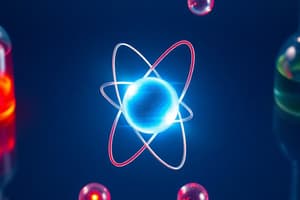Podcast
Questions and Answers
Which atomic model introduced the concept of electrons orbiting the nucleus?
Which atomic model introduced the concept of electrons orbiting the nucleus?
- Plum pudding model
- Electron cloud model
- Modern quantum mechanical model
- Rutherford model (correct)
Which atomic model violates the Heisenberg Uncertainty Principle?
Which atomic model violates the Heisenberg Uncertainty Principle?
- Rutherford model
- Electron cloud model
- Modern quantum mechanical model (correct)
- Plum pudding model
Which atomic model posits that the positive charge is evenly distributed throughout the atom?
Which atomic model posits that the positive charge is evenly distributed throughout the atom?
- Modern quantum mechanical model
- Rutherford model
- Electron cloud model
- Plum pudding model (correct)
Which atomic model introduced the concept of energy levels for electrons?
Which atomic model introduced the concept of energy levels for electrons?
Which atomic model was the first to propose a dense, small nucleus?
Which atomic model was the first to propose a dense, small nucleus?
Which atomic model proposed that electrons are distributed in a cloud-like manner throughout the atom?
Which atomic model proposed that electrons are distributed in a cloud-like manner throughout the atom?
Who proposed the plum pudding model, which envisions the atom as a sphere of positive charge with electrons dispersed throughout?
Who proposed the plum pudding model, which envisions the atom as a sphere of positive charge with electrons dispersed throughout?
Which atomic model suggests that atoms are composed of smaller constituent parts and are not indivisible?
Which atomic model suggests that atoms are composed of smaller constituent parts and are not indivisible?
Which atomic model proposes that the atom's structure consists of a nucleus containing most of the atom's mass and positive charge, with electrons orbiting this nucleus?
Which atomic model proposes that the atom's structure consists of a nucleus containing most of the atom's mass and positive charge, with electrons orbiting this nucleus?
Which atomic model is the most advanced and complex, incorporating principles from both classical physics and quantum mechanics to explain the behavior of atoms?
Which atomic model is the most advanced and complex, incorporating principles from both classical physics and quantum mechanics to explain the behavior of atoms?
Flashcards are hidden until you start studying
Study Notes
Atomic Models: A Historical Overview
Atomic models are theoretical frameworks used to describe the structure and composition of atoms. Throughout history, scientists have proposed various models to explain the nature of atoms, from the early plum pudding model to the more modern quantum mechanical model. This article will provide a comprehensive overview of the key atomic models, including the plum pudding model, electron cloud model, Rutherford model, and modern quantum mechanical model.
Plum Pudding Model
The plum pudding model, also known as the J.J. Thomson model, was proposed in 1900 by English physicist J.J. Thomson. It envisions the atom as a sphere of positive charge, with electrons dispersed throughout like plums in a pudding. Thomson discovered the electron in 1897 using cathode rays and found that it was negatively charged and much lighter than hydrogen. This model was the first to suggest that atoms were not indivisible but rather composed of smaller constituent parts.
Electron Cloud Model
The electron cloud model, also known as the Thomson electron cloud model, is a more advanced version of the plum pudding model. It proposes that electrons are distributed throughout the atom in a cloud-like manner, with a uniform distribution of positive charge surrounding the electrons. This model was an improvement over the plum pudding model, as it better explained the observed scattering of electrons in experiments.
Rutherford Model
In 1911, New Zealand-born British physicist Ernest Rutherford proposed the Rutherford model, which significantly advanced our understanding of atomic structure. Rutherford's gold foil experiment involved firing alpha particles at a thin sheet of gold foil and observing their scattering patterns. The results showed that most of the particles passed through the foil with little or no deflection, while a small number were deflected at large angles. This led Rutherford to conclude that the positive charge in an atom was concentrated in a small, dense nucleus, with the electrons orbiting around it.
Modern Quantum Mechanical Model
The modern quantum mechanical model, also known as the Bohr model, was proposed by Danish physicist Niels Bohr in 1913. It is based on quantum theory and the concept of energy levels or shells of electrons. In this model, electrons can only occupy specific energy levels, and they can move between these levels by absorbing or emitting energy. Bohr's model addressed some of the stability problems in Rutherford's model but was later found to have limitations, such as violating the Heisenberg Uncertainty Principle.
Conclusion
Atomic models have evolved significantly over time, from the early plum pudding model to the more advanced quantum mechanical model. Each model has contributed to our understanding of atomic structure and composition, ultimately leading to a more comprehensive and accurate picture of the atom.
Studying That Suits You
Use AI to generate personalized quizzes and flashcards to suit your learning preferences.



